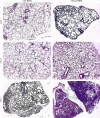A recruitment breath manoeuvre directly after endotracheal suction improves lung function: an experimental study in pigs
- PMID: 19736601
- PMCID: PMC2852766
- DOI: 10.1080/03009730903177357
A recruitment breath manoeuvre directly after endotracheal suction improves lung function: an experimental study in pigs
Abstract
Background: Atelectasis occurs after a well performed endotracheal suction. Clinical studies have shown that recruitment manoeuvres added after endotracheal suction during mechanical ventilation restore lung function. Repetitive lung over-distension is, however, harmful for the lung, and the effects of adding a larger breath, recruitment breath, directly after repeated endotracheal suction were therefore investigated.
Methods: Twelve healthy anaesthetized pigs were randomized into two groups: one without and one with a recruitment breath manoeuvre (RBM), i.e. a breath 15 cmH(2)O above inspiratory pressure for 10 s during pressure-controlled ventilation. The pigs were suctioned every hour for 4 hours with an open suction system.
Results: At the end of the study there was a statistically significant difference between the group given RBM and that without with respect to PaCO(2), tidal volume (V(T)), and compliance (Crs). Without RBM, the PaCO(2) increased from 4.6+/-0.4 to 6.1+/-1.5 kPa, V(T) decreased from 345+/-39 to 247+/-71 mL, and Crs decreased from 28+/-6 to 18+/-5 mL/cmH(2)O. There was no change in PaCO(2) or Crs when a RBM was given. Morphological analysis revealed no differences in aeration of apical and central lung parenchyma. In the basal lung parenchyma there were, however, greater areas with normal lung parenchyma and less atelectasis after RBM.
Conclusions: Atelectasis created by endotracheal suction can be opened by inflating the lung for a short duration with low pressure, without over-distension, immediately after suction.
Figures

Similar articles
-
Post-suction recruitment manoeuvre restores lung function in healthy, anaesthetized pigs.Anaesth Intensive Care. 2004 Jun;32(3):339-45. doi: 10.1177/0310057X0403200306. Anaesth Intensive Care. 2004. PMID: 15264727
-
Side effects of endotracheal suction in pressure- and volume-controlled ventilation.Chest. 2004 Mar;125(3):1077-80. doi: 10.1378/chest.125.3.1077. Chest. 2004. PMID: 15006972
-
A recruitment manoeuvre performed after endotracheal suction does not increase dynamic compliance in ventilated paediatric patients: a randomised controlled trial.Aust J Physiother. 2007;53(3):163-9. doi: 10.1016/s0004-9514(07)70023-5. Aust J Physiother. 2007. PMID: 17725473 Clinical Trial.
-
[Comparative study of recruitment maneuver guided by pressure-volume curve on respiratory physiology and lung morphology between acute respiratory distress syndrome of pulmonary and extrapulmonary origin in canine models].Zhongguo Wei Zhong Bing Ji Jiu Yi Xue. 2011 Jan;23(1):36-9. Zhongguo Wei Zhong Bing Ji Jiu Yi Xue. 2011. PMID: 21251365 Chinese.
-
Bench-to-bedside review: adjuncts to mechanical ventilation in patients with acute lung injury.Crit Care. 2005 Oct 5;9(5):465-71. doi: 10.1186/cc3763. Epub 2005 Jun 28. Crit Care. 2005. PMID: 16277735 Free PMC article. Review.
References
-
- Rothen HU, Sporre B, Engberg G, Wegenius G, Hedenstierna G. Airway closure, atelectasis and gas exchange during general anaesthesia. Br J Anaesth. 1998;81:681–6. - PubMed
-
- Hedenstierna G, Rothen HU. Atelectasis formation during anesthesia: causes and measures to prevent it. J Clin Monit Comput. 2000;16:329–35. - PubMed
-
- Nunn J, Williams IP, Jones JG, Hewlett AM, Hulands GH, Minty BD. Detection and reversal of pulmonary absorption collapse. Br J Anaesth. 1978;50:91–100. - PubMed
-
- Benjamin JJ, Cascade PN, Rubenfire M, Wajszczuk W, Kerin NZ. Left lower lobe atelectasis and consolidation following cardiac surgery: the effect of topical cooling on the phrenic nerve. Radiology. 1982;142:11–14. - PubMed
-
- Goodman L. Postoperative chest radiographs: 1. Alterations after abdominal surgery. Am J Roentgenology. 1980;134:533–41. - PubMed
Publication types
MeSH terms
LinkOut - more resources
Full Text Sources
